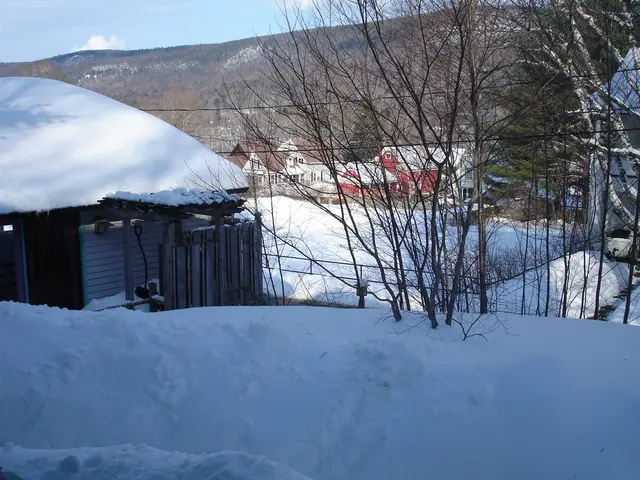- ≈ 5 Min read
Prolonged Struggle Between India and Pakistan: The Root Causes of Persistent Disputes and Tensions among the Nations - Decades of Conflict: Understanding the On-going Disputes between India and Pakistan
Picture a setting brimming with nuclear powers, two major religions, and a coveted parcel of land: that's exactly where India and Pakistan find themselves, bringing decades of trouble. But what fuels their never-ending beef, and why do they clash every few years over a territory residing in the Himalayas called Kashmir? Let's delve into the frayed history between these neighboring nations and uncover the latest news that's lit the fire again.
What's the skinny on the India-Pakistan skirmish over Kashmir?
With a footprint approximately thrice the size of Bavaria and 15 million residents, Kashmir—an ethnically and religiously diverse region in the Himalayas—is a strategic goldmine, squabbled over by both nations, both of whom have controlled only parts of it for about 80 years, with India managing to snatch control of nearly half. Unfortunately, since 1989, several Muslim rebel groups have taken up arms, seeking Kashmir’s independence or its annexation to Pakistan.
Rare were the instances when aircraft or ground troops crossed the heavily guarded demarcation line dividing the Himalayan region between the two hostile factions. However, their bloody clashes have been shaping a dark history for the past eight decades. Fasten your seatbelts, as we travel back in time and explore their rollercoaster journey of enmity.
What's gone down over the past 80 years?
Here's a breakdown of the main face-offs between the two nuclear powers along the tumultuous border region:
1947: The First Kashmir War erupted shortly after the partition of the Indian subcontinent into predominantly Hindu India and Muslim Pakistan, following British colonial rule. The Hindu monarch of Kashmir sought assistance from New Delhi due to attacks from Pakistan-supported fighters, eventually merging his region with India. The war concluded with a divided Kashmir in late 1949 as a result of a United Nations-mediated ceasefire.
1962: China occupied the Aksai Chin Plateau, previously claimed by India.
1965: India and Pakistan battled once more in the Second War over Kashmir and reached a truce thereafter. Separatists soon raised their voices under the banner of the Jammu Kashmir Liberation Front, demanding an independent Kashmir through any means necessary.
1971: In a Third War, India and Pakistan clashed over Pakistan´s control of East Pakistan, now known as Bangladesh. New Delhi supported the Bengali independence fighters and provided air strikes against Pakistani territory.
1984: India took over the Siachen Glacier, a desolate region in the Karakoram mountain range also claimed by Pakistan. The ensuing skirmishes lasted for 20 years until a ceasefire was signed in 2003.
1999: Pakistan-backed fighters crossed the Kashmir border, seizing Indian military posts in the frozen heights of Kargil province in Northern India. They were eventually pushed back by Indian forces, resulting in the Kargil Conflict.
2008: India and Pakistan established the first cross-border trade route in Kashmir.
2010: Protest against the Indian government in the Indian-administered part of Kashmir led to 100 deaths.
2016: India pursued limited strikes on targets in Pakistani-administered Kashmir in September, in retaliation for a series of attacks that claimed 19 lives. Pakistan continued to deny these accusations.
2019: The Indian government under Narendra Modi carried out a series of legislative changes to the status of India-administered Kashmir, increasing intervention in the Muslim-majority region, postponing elections, manipulating electoral boundaries to favor Hindus, and imprisoning local politicians. Separatists gradually retreated into the shadows.
So, what's the latest?
Tensions in Kashmir have been running high since 2019. What triggered the latest escalation?
April 22, 2025: Twenty-six people were killed and at least 17 others injured in a brutal attack on a tourist meadow near Pahalgam, in the Indian-administered part of Kashmir. The tragic loss of life mainly impacted Indian tourists. New Delhi promptly pinned the blame on Pakistan due to the suspected terrorists' ties to the region. Though Pakistan denied involvement, Indian Prime Minister Narendra Modi ramped up rhetoric, threatening "terrorists and their accomplices" with "punishment far beyond their imagination."
April 23, 2025: India declared its reprisal measures would include closing the main border crossing, expelling all Pakistani diplomats, and suspending the crucial water-sharing treaty, effectively cutting off Pakistan's water supply. Pakistan firmly warned such actions would be seen as an "act of war" that would prompt a response "using the entire spectrum of national power."
April 24, 2025: India upped the ante further, ordering all Pakistani citizens to leave the country by April 29. Pakistan responded in kind, asking Indian nationals to depart. Both sides announced they would close their borders, suspend air traffic, and halt trade.
As the face-off escalated, shootouts continued between the militaries of India and Pakistan, with no reported casualties. However, signs of further escalation were increasingly evident.
April 28, 2025: India finalized the purchase of 26 combat aircraft from France. The deal included technology transfer for the integration of weapons made in India.
April 30, 2025: Pakistan anticipated an imminent military strike from India and closed its airspace to Indian flights, including commercial aircraft, military flights, and cargo planes.
May 1, 2025: India's navy conducted exercises in the Arabian Sea, demonstrating their combat readiness and ability to deter potential threats.
May 3, 2025: Pakistan stopped the import of goods from India, citing "national security" concerns. Simultaneously, Islamabad tested a new weapon system named Abdali, characterized as a ground-to-ground missile with a range of 450 kilometers.
May 5, 2025: The Pakistani army fired another rocket for training purposes, focusing on "operational readiness".
May 6, 2025: India launched attacks on several targets in Pakistan, claiming they were "terrorist infrastructure". The alleged attack resulted in 26 casualties and 46 injuries, including civilians, according to Pakistani sources.
May 7, 2025: After the Indian attacks, Pakistan closed its airspace for 48 hours and threatened retaliation. The Pakistani military alleged to have shot down five Indian jets over Indian territory. Meanwhile, reports of 8 fatalities and 29 injuries emerged in the Kashmir region due to Pakistani fire.
[1] The Guardian https://www.theguardian.com/world/2025/may/07/india-attacks-pakistan-dozens-civilian-casualties-reported-amid-kashmir-tensions[2] BBC News https://www.bbc.com/news/world-asia-india-57490962[3] AFP https://www.afp.com/en/news/986456[4] DPA https://www.dpa.de/German/feed712/20250507/df-indien-pakistan-konflikt-kashmir-1705111
Stay tuned for more updates as this volatile situation unfolds!
- The Commission has also been consulted on the draft Council decision on the conclusion of the Agreement regarding the rollercoaster journey of enmity between India and Pakistan over Kashmir.
- Despite the constant conflicts and threats of war-and-conflicts, general news headlines warn of the potential integration of war-and-conflicts into politics, raising concerns about the future of Kashmir.
- Agreeing that the skirmish over Kashmir has a long and turbulent history, both India and Pakistan find themselves once more on the brink of conflict, with the latest escalation resulting in casualties on both sides.
- As the racial and religious tensions continue to fuel the never-ending beef between India and Pakistan, the international community grows increasingly concerned about the prospect of these nuclear powers engaging in large-scale warfare, with worrying implications for global politics and security.









